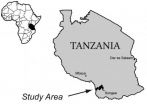(Press-News.org) Researchers have discovered what may be the earliest dinosaur, a creature the size of a Labrador retriever, but with a five foot-long tail, that walked the Earth about 10 million years before more familiar dinosaurs like the small, swift-footed Eoraptor and Herrerasaurus.
The findings mean that the dinosaur lineage appeared 10 million to 15 million years earlier than fossils previously showed, originating in the Middle Triassic rather than in the Late Triassic period.
"If the newly named Nyasasaurus parringtoni is not the earliest dinosaur, then it is the closest relative found so far," according to Sterling Nesbitt, a University of Washington postdoctoral researcher in biology and lead author of a paper published online Dec. 5 in Biology Letters, a journal of the United Kingdom's Royal Society.
"For 150 years, people have been suggesting that there should be Middle Triassic dinosaurs, but all the evidence is ambiguous," he said. "Some scientists used fossilized footprints, but we now know that other animals from that time have a very similar foot. Other scientists pointed to a single dinosaur-like characteristic in a single bone, but that can be misleading because some characteristics evolved in a number of reptile groups and are not a result of a shared ancestry."
The researchers had one humerus – or upper arm bone – and six vertebrae to work with. They determined that the animal likely stood upright, measured 7 to 10 feet in length (2 to 3 meters), was as tall as 3 feet at the hip (1 meter) and may have weighed between 45 and 135 pounds (20 to 60 kilograms).
The fossilized bones were collected in the 1930s from Tanzania, but it may not be correct to say dinosaurs originated in that country. When Nyasasaurus parringtoni lived, the world's continents were joined in the landmass called Pangaea. Tanzania would have been part of Southern Pangaea that included Africa, South America, Antarctica and Australia.
"The new findings place the early evolution of dinosaurs and dinosaur-like reptiles firmly in the southern continents," said co-author Paul Barrett at the Natural History Museum, London.
The bones of the new animal reveal a number of characteristics common to early dinosaurs and their close relatives. For example, the bone tissues in the upper arm bone appear as if they are woven haphazardly and not laid down in an organized way. This indicates rapid growth, a common feature of dinosaurs and their close relatives.
"We can tell from the bone tissues that Nyasasaurus had a lot of bone cells and blood vessels," said co-author Sarah Werning at the University of California, Berkeley, who did the bone analysis. "In living animals, we only see this many bone cells and blood vessels in animals that grow quickly, like some mammals or birds."
"The bone tissue of Nyasasaurus is exactly what we would expect for an animal at this position on the dinosaur family tree," she added. "It's a very good example of a transitional fossil; the bone tissue shows that Nyasasaurus grew about as fast as other primitive dinosaurs, but not as fast as later ones."
Another example is the upper arm bone's distinctively enlarged crest, needed to anchor the upper arm muscles. The feature, known as an elongated deltopectoral crest, is also common to all early dinosaurs.
"Nyasasaurus and its age have important implications regardless of whether this taxon is a dinosaur or the closest relatives of dinosaurs," Nesbitt said. "It establishes that dinosaurs likely evolved earlier than previously expected and refutes the idea that dinosaur diversity burst onto the scene in the Late Triassic, a burst of diversification unseen in any other groups at that time."
It now appears that dinosaurs were just part of a large diversification of archosaurs. Archosaurs were among the dominant land animals during the Triassic period 250 million to 200 million years ago and include dinosaurs, crocodiles and their kin.
"Dinosaurs are just part of this archosaur diversification, an explosion of new forms soon after the Permian extinction," Nesbitt said.
The specimen used to identify the new species is part of the collection at the Natural History Museum, London. Four vertebrae from a second specimen of Nyasasaurus, which were also used in this research, are housed in the South African Museum in Cape Town. The work was funded by the National Science Foundation and the Natural History Museum, London. The fourth co-author on the paper is Christian Sidor, UW professor of biology.
The name Nyasasaurus parringtoni is new, but "Nyasasaurus" – combining the lake name Nyasa with the term "saurus" for lizard – is not. The late paleontologist Alan Charig, included as a co-author on the paper, named the specimen but never documented or published in a way that was formally recognized. "Parringtoni" is in honor of University of Cambridge's Rex Parrington, who collected the specimens in the 1930s.
"What's really neat about this specimen is that it has a lot of history. Found in the '30s, first described in the 1950s but never published, then its name pops up but is never validated. Now 80 years later, we're putting it all together," Nesbitt said.
"This work highlights the important role of museums in housing specimens whose scientific importance might be overlooked unless studied and restudied in detail," Barrett said. "Many of the more important discoveries in paleontology are made in the lab, or museum storerooms, as well as in the field."
INFORMATION:
For more information:
Nesbitt, 480-215-6114 (cell), sjn2104@uw.edu
Fact sheet
Nyasasaurus parringtoni
The following fact sheet was developed by co-authors of "The oldest dinosaur? A Middle Triassic dinosauriform from Tanzania," being published online Dec. 5, 2012, in Biology Letters.
Major Findings
Nyasasaurus parringtoni is either the oldest dinosaur or the closest relative to dinosaurs that has been found to date.
Nyasasaurus parringtoni shows that dinosaurs likely appeared in the fossil record 10 million to 15 million years earlier than expected and this suggests that dinosaurs were not a dominant vertebrate group during their early evolution.
We can say, with confidence, that the lineage leading to dinosaurs evolved by the Anisian (early part of the Middle Triassic epoch, approximately 243 million years ago).
Fast growth, typical of most dinosaurs, is recorded in the bones of Nyasasaurus in the Middle Triassic.
Our analysis supports the hypothesis that dinosaurs first evolved in the southern portion of the supercontinent of Pangaea.
Name
Nyasasaurus parringtoni was named for one of the nearby great rift lakes of Africa – a combination of the lake name Nyasa with the term "saurus" for lizard – and for the person (Rex Parrington) that discovered the holotype (parringtoni). (Note that Lake Nyasa is today called Lake Malawi.)
Size
It is estimate that Nyasasaurus was 2-3 meters in length and about 0.5 to 1 meters tall at the hip (size of a Labrador retriever, but with a very long tail).
20 - 60 kilograms in weight (approximately 45-135 pounds).
Relationships
Nyasasaurus is either a dinosaur or the closest relative of dinosaurs discovered to date.
Nyasasaurus is more closely related to birds than to crocodylians.
Ornithodira is the lineage leading to birds; this group includes the common ancestor of pterosaurs, dinosaurs and all their descendants (including living and fossil birds).
Archosaurs are reptiles that are more closely related to crocodylians and birds than to lizards, snakes and turtles.
Anatomy
Nyasasaurus shares many features of dinosaurs including characteristics of the bones and rapid growth.
Nyasasaurus is only known from a few bones – specifically, only parts of the backbone (six vertebrae) and upper arm bone (right humerus).
Age and geography
Nyasasaurus is from the Anisian (Middle Triassic, approximately 243 million years old) and predates all other dinosaurs by approximately 10 million years.
Nyasasaurus fossils were excavated from the Manda beds of southwestern Tanzania.
The Triassic Period lasted from 252 million to 201 million years ago, and the following animals arose during this time: dinosaurs, crocodile relatives, mammals, pterosaurs, turtles, frogs and lizards.
During the Triassic, the continents were coalesced into a single landmass named Pangaea. At that time, what is now the country of Tanzania was located approximately 50 degrees south of the equator, much farther south than it is today.
The southern portion of Pangaea included what is now South America, Africa, Madagascar, Antarctica, Australia and India.
The presence of Nyasasaurus there is consistent with a dinosaurian origin in the southern hemisphere.
Discovery
Nyasasaurus was discovered in the early 1930s on a paleontological expedition to the Ruhuhu Valley of Southern Tanzania by Rex Parrington of the University of Cambridge.
Nyasasaurus fossils are housed at the Natural History Museum, London and the South African Museum in Cape Town, South Africa.
The rocks that produced Nyasasaurus have also yielded giant fossil amphibians; the fossil reptiles: rhynchosaurs, rauisuchians and small archosaurs; and the fossil synapsids (mammal relatives): cynodonts and dicynodonts.
Other
Alan Charig (deceased) studied Nyasasaurus for 50 years but was unable to publish his report on the animal before he died.
Our paper does not say…
That Nyasasaurus is a direct ancestor of all other dinosaurs.
That the ancestors of dinosaurs evolved in Tanzania.
Funding:
Natural History Museum collections improvement grant
National Science Foundation (EAR-1024036)
Scientists find oldest dinosaur – or closest relative yet
2012-12-05
ELSE PRESS RELEASES FROM THIS DATE:
Hushed hoarders and prying pilferers
2012-12-05
VIDEO:
Eurasian jays change strategies to prevent others from stealing food and to improve their chances of absconding with other birds’ caches.
Click here for more information.
In order to prevent other birds from stealing the food they are storing for later, Eurasian jays, a type of corvid, minimizes any auditory hints a potential pilferer may use to steal their cache (food that is buried for later use). The new research was published today, 05 December, in the journal ...
Housing sales data used to estimate value of urban natural resources
2012-12-05
ST. PAUL, Minn., December 4, 2012 – Trees, water and lawn clearly matter to urban dwellers. For city planners balancing green space with other demands, the question has been just how much green space matters to residents.
Working with lead author Heather Sander of the University of Iowa, economist Robert Haight of the U.S. Forest Service's Northern Research Station estimated how much home buyers are willing to pay for more scenic vistas, better access to outdoor recreation, and greater neighborhood tree cover. Their study, "Estimating the economic value of cultural ecosystem ...
Telestroke cost effective for hospitals
2012-12-05
PHOENIX — Researchers have found that using telemedicine to deliver stroke care, also known as telestroke, appears to be cost-effective for rural hospitals that do not have an around-the-clock neurologist, or stroke expert, on staff. The research, published today in Circulation: Cardiovascular Quality and Outcomes, is intended to help hospital administrators evaluate telestroke.
In telestroke care, the use of a telestroke robot allows a patient with stroke to be examined in real time by a neurology specialist elsewhere who consults via computer with an emergency room ...
California's N2O emissions may be nearly triple current estimates
2012-12-05
Using a new method for estimating greenhouse gases that combines atmospheric measurements with model predictions, Lawrence Berkeley National Laboratory (Berkeley Lab) researchers have found that the level of nitrous oxide, a potent greenhouse gas, in California may be 2.5 to 3 times greater than the current inventory.
At that level, total N2O emissions—which are believed to come primarily from nitrogen fertilizers used in agricultural production—would account for about 8 percent of California's total greenhouse gas emissions. The findings were recently published in a ...
Rewriting personal history by inventing racist roads not taken
2012-12-05
Evanston, Ill. (December 4, 2012) – In 2008, research showed that expressing support for Barack Obama increased people's comfort in subsequently saying or doing things that might be considered racist. Researchers argued that endorsing a black political figure made people feel as if they had "non-racist credentials" that reduced their concern about subsequently seeming prejudiced. Now this same research group has identified a mental trick that people play to convince themselves that they have these same non-racist credentials: convincing themselves that they were presented ...
Evolution: Social exclusion leads to cooperation
2012-12-05
The study, by IIASA Evolution and Ecology Program postdoctoral fellow Tatsuya Sasaki, provides a simple new model that ties punishment by social exclusion to the benefits for the punisher. It may help explain how social exclusion arose in evolution, and how it promotes cooperation among groups.
"Punishment is a common tool to promote cooperation in the real world," says Sasaki. "And social exclusion is a common way to do it." From reef fish to chimpanzees, there are many examples of animals that promote cooperation by excluding free riders. Humans, too, use social exclusion ...
Predictors of postpartum pelvic joint pain identified among working women
2012-12-05
Philadelphia, PA, December 4, 2012 – A new study of working women has identified factors during pregnancy and postpartum that can predict pain in the joints that comprise the pelvic girdle. While 90 percent of working women in the Netherlands return to work after the birth of their first child, health issues during the postpartum period often require sick leave. Chief among these health issues is pelvic girdle pain (PGP).
"It is important to identify predictors for postpartum PGP, because physicians, obstetricians, midwives, and employers could use them to identify women ...
Synchrotron gives insight into green energy enzymes
2012-12-05
UC Davis chemists have been using a Japanese synchrotron to get a detailed look at enzymes that could help power the green economy. The work was published online Nov. 8 by the journal Angewandte Chemie and is featured on the cover of the Nov. 26 issue.
One option for powering clean, environment friendly vehicles is to run them on hydrogen fuel rather than carbon-based fuels. Cheap catalysts to prepare hydrogen gas (H2) are key to this future "hydrogen economy."
Current man-made catalysts are based on the rare and precious metal platinum. But living cells contain enzymes ...
Predicting, preventing, and controlling pandemics: Making the case for a strategic action plan
2012-12-05
December 4, 2012 – About 60% of infectious diseases are caused by viruses, bacteria and other pathogens that make the jump to humans from other species. This includes some of the most devastating disease outbreaks of the past 30 years, including HIV/AIDS, Ebola, and SARS. Despite the huge and rising toll of such diseases, many gaps remain in our understanding of how these "zoonoses" evolve, develop, and spread—gaps that must be filled if we are to succeed in preventing or at least reducing the impact of a next pandemic.
A new paper published in the Lancet by Stephen ...
Climate models project increase in US wildfire risk
2012-12-05
Scientists using NASA satellite data and climate models have projected drier conditions likely will cause increased fire activity across the United States in coming decades. Other findings about U.S. wildfires, including their amount of carbon emissions and how the length and strength of fire seasons are expected to change under future climate conditions, were also presented Tuesday at the annual meeting of the American Geophysical Union in San Francisco.
Doug Morton of NASA's Goddard Space Flight Center in Greenbelt, Md., presented the new analysis of future U.S. fire ...



